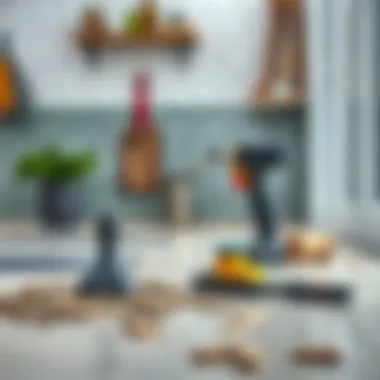Expert Strategies for Removing Kitchen Floor Tiles


Intro
Tackling a kitchen renovation can be an exciting yet daunting task, especially when it comes to removing those old, worn-out floor tiles. Whether you're aiming for a chic, modern look or just wanting to update the tired aesthetics of your kitchen, understanding the process of tile removal is crucial. Removing kitchen floor tiles is not just about the physical act of tearing them up; it's about ensuring that the underfloor remains intact for whatever you plan next.
This guide will lead you through the essential steps, from preparation to cleanup, giving you the confidence to take on this DIY project. Renovating your kitchen not only enhances your cooking environment but also increases the value of your home, making it a worthwhile investment.
"A well-planned renovation can transform a space, breathing new life into your home and making it truly your own."
So grab your tools and roll up your sleeves; it's time to get into the nitty-gritty of removing those pesky tiles.
Intro to Tile Removal
Removing kitchen floor tiles can seem like a daunting task, but understanding the ins and outs of the process can make it a whole lot easier. It’s not just about ripping away tiles; it’s about proper technique and preparation that sets the stage for a successful renovation. This phase is crucial as it safeguards not only the integrity of your underlayment but also influences how smoothly the rest of your project will proceed.
Understanding the Importance of Proper Techniques
Applying the right techniques during tile removal is like laying a solid foundation for a house. If not done correctly, one might end up damaging the subfloor, which could lead to costly repairs down the line. For instance, aggressive methods could chip or crack the subfloor. Moreover, proper techniques ensure that the tiles come off cleanly and efficiently, reducing the mess and effort needed for cleanup.
One key technique involves starting at the edges of the tiled area. This often yields better results than a head-on approach against the center. By working methodically, you can avoid unnecessary damage and significantly simplify the task ahead.
Common Reasons for Tile Removal
There are a multitude of reasons why homeowners may decide to remove tiles from their kitchens. Here are a few notable ones:
- Aesthetic Upgrades: Perhaps the original tiles are outdated or don’t fit the new décor. It’s common for people to want a fresh look as kitchen trends evolve.
- Repairing Damage: Tiles can crack or chip over time, leading to potential water damage. In such cases, removal may not only be preferable but necessary to address underlying issues.
- Changing Functionality: Shifting from tile to a different flooring material, like hardwood or vinyl, could better suit the homeowner’s needs or lifestyle.
- Increased Value: Renovating the kitchen can enhance the overall appeal of a home, making it more attractive to potential buyers.
In summary, understanding the nuances of tile removal is essential for achieving desired renovations without incurring additional problems. Whether it’s driven by the desire for aesthetic improvements or a more functional space, preparing properly can ensure that the entire removal process goes off without a hitch.
Preparation for the Task
Preparing to remove kitchen floor tiles is crucial for a seamless execution of the project. This foundational step sets the stage, ensuring that you have all needed materials and a clear plan of action, which can save both time and effort. Without proper preparation, one might encounter unnecessary obstacles that can derail the progress. From breaking a tile only to find mismatched tools to risking damage to nearby items, the lack of prep can lead to a domino effect of errors.
Being mindful of this phase helps in identifying potential challenges ahead of time. It enables you to approach the task like a seasoned pro rather than a deer caught in headlights.
Assessing the Type of Tiles
To kick things off, understanding the type of tiles in place is essential. Not every tile is cut from the same cloth—some are glued down tighter than an old shoe, while others might lift like a cork on water. Knowing whether they are ceramic, porcelain, or even vinyl can affect your removal technique. For instance, porcelain tiles usually require a bit more elbow grease than their ceramic counterparts. Furthermore, older tiles may present additional challenges if they are set with outdated adhesives, possibly needing specialized approaches for removal.
Gathering Necessary Tools
Having the right arsenal on hand is paramount when it comes to removing tiles. Below are key tools and their significance in your endeavor:


Tile cutter
A tile cutter is a handy tool for making precise cuts in tiles before or during the removal process. Its humble design directs more than just blade functionality; it can be a game changer specifically when you need clean edges or to work around odd shapes in your kitchen. One of the standout characteristics of a tile cutter is its ability to reduce chipping. Less debris means less cleaning later, which is a plus. However, it's important to note that if you have particularly thick tiles, a manual cutter might not do the trick. You may find a power tool, like a wet saw, becomes your best friend.
Grout remover
A grout remover becomes your trusty companion before diving into tile removal. This tool is specially designed to clear out the joint material between tiles, making it easier to lift them afterward. With a sharp edge, it can tackle old, hardened grout that just won’t budge. The unique feature here is its ergonomic design, allowing for maximum grip and control. A downside, though, is that using it requires patience—you can't rush the process, or you risk damaging the adjacent tiles.
Pry bar
This tool is critical for loosening tiles that may not come up with a gentle nudge. A pry bar lets you apply leverage, helping in prying the stubborn tiles off the floor. Its stringent, sturdy build allows a firm grip underneath the tile, effectively distributing pressure. The upside is it can pull up even the most reluctant tiles, but be cautious: misuse can lead to chips in your subfloor, ultimately causing further headaches.
Safety goggles
Safety goggles might seem like a minor detail, but they are crucial for shielding your eyes from debris. When you're hammering away, tiny bits can fly anywhere—eyes are particularly sensitive, and a little protection goes a long way. Choose goggles that fit snugly to keep dust at bay. Their presence is not just precautionary; it's a wise investment in your safety.
Gloves
Finally, gloves are essential for keeping your hands safe from sharp edges and the abrasive materials you will encounter. They provide a buffer against lacerations while also enhancing grip on tools. A notable characteristic is their variety—from heavy-duty ones to lightweight designs that offer dexterity. While thick gloves offer plenty of protection, they might compromise on finesse, so consider the tasks ahead when picking a pair.
Creating a Safe Work Environment
Creating a safe work environment can’t be overstated. It’s the difference between a smooth operation and a world of chaos. If things aren't stable, accidents abound.
Clearing the Area
Clearing the area involves not just moving furniture but being strategic about potential hazards. By making room, you ensure you’ll have enough space to maneuver without risking injury or damaging your belongings. This step helps in creating an organized workspace, ultimately improving focus on the task.
Providing Adequate Ventilation
On the topic of safety, providing adequate ventilation is another crucial aspect. Flooring adhesive can release fumes, and cutting tiles often creates dust that isn't pleasant to breathe. Open windows, and perhaps use fans to circulate the air. This simple act does wonders for comfort during the project, keeping you sharp and reducing health risks. A well-ventilated area demands minimal effort but pays off substantially in the long run.
Remember, a solid preparation phase can turn an overwhelming task into an organized and efficient mission. Equip yourself properly, clear your workspace, and you’ll be well on your way to tile removal success.
Techniques for Tile Removal
Removing tiles isn't just a matter of yanking them off the floor and hoping for the best. The techniques employed can make or break the entire project. A solid approach reduces damage and saves you time and frustration down the line. When done right, these techniques ensure that the underlying structure remains intact for your new tiles, thus offering a smooth transition into your home renovation efforts.
Removing Grout Effectively
Before you can get to the tiles themselves, it's crucial to remove the grout that binds them to the surface. Grout removal can be tedious, but it's essential. A grout saw or a rotary tool equipped with a grout removal blade works wonders here. You need to be thorough, as remnants of grout can make tile removal immensely difficult.
Use slow, steady motions to cut through the grout without damaging the tiles. Pay close attention especially around edges. After cutting, use a pry bar to pop tiles off. This step cannot be rushed. Patience here pays off—literally!


Using a Chisel and Hammer
Got stubborn tiles that just won't budge? Dust off that chisel! Using a chisel along with a hammer allows for precise strikes that help in loosening tiles that may be clamped down by adhesive. Start by positioning the chisel at a slight angle against the tile edge, ensuring it won’t slip off.
One solid whack with the hammer can be all it takes to crack a tile. Remember, you’re not throwing around sledgehammers—gentle precision is key. Working from the corner of the tile often yields better results. Repeat as necessary, and soon enough, you'll have those tiles up and maybe even some sous-chef remorse about the whole endeavor!
Leveraging Heat for Stubborn Tiles
Sometimes, no matter how many tools you have in your box, tiles cling on like a tenacious ex. In such cases, heat can come to the rescue. A heat gun can soften the adhesive beneath the tiles, making them easier to pry up once they've been warmed. Start by applying heat evenly across the tile surface.
Once the adhesive feels pliable, try using a pry bar or putty knife to lift the edges. But be cautious! Heat can also damage the tile. Always test a small area first. If it looks like those stubborn tiles are about to break ranks, you've got a win.
Employing a Floor Scraper
Once you've lifted the tiles, the work isn't over yet. A floor scraper is your best mate when it comes to cleaning up. This tool is excellent for removing leftover adhesive that decided to stick around after the tiles left the building. With the blade facing down, push the scraper across the floor to shave off any stubborn spots.
You may need some elbow grease here—don't shy away! Make sure you keep the angle consistent for an even finish. Remember, each smooth stroke makes way for a fresh new surface that is ready for the next thrilling chapter in your home’s renovation journey.
Post-Removal Cleanup
After you've put in the hard work to remove those kitchen floor tiles, it might feel like you can finally kick back and relax. However, the cleanup phase is just as vital as the removal process itself. Neglecting this phase can lead to a range of issues down the road, whether you're prepping for new flooring or just looking to keep your space clean and functional. Let’s break down why post-removal cleanup matters and explore its main components.
Removing Residual Adhesive
The leftover adhesive is often the trickiest part to deal with after tiles are taken out. It can stick around like an unwanted houseguest, stubbornly clinging to the subfloor. Why is it essential to get rid of this? If residual adhesive is not completely removed, it can interfere with the installation of any new flooring. Here’s how to tackle it:
- Scraping: Use a putty knife or a floor scraper to gently remove the bulk of the adhesive. Make sure to be gentle to avoid damaging the subfloor.
- Chemical Removers: If scraping alone isn’t cutting it, consider specialized adhesive removers. These products are designed to break down the stubborn glue and can save you a lot of elbow grease.
- Sanding: For particularly tough spots, a sanding block can work wonders. Just be cautious—sanding too aggressively may cause scratches or uneven spots on the subfloor.
Tip: Always wear gloves and use adequate ventilation when using chemical removers.
Assessing the Condition of the Subfloor
Once the adhesive is cleared away, take a good look at the subfloor. Understanding its condition is crucial for a successful flooring installation. Issues like moisture, warping, or even structural damage could hinder your plans. Here are steps to guide your assessment:
- Visual Inspection: Look for cracks, unevenness, or signs of rot. Any of these could indicate underlying problems.
- Check Moisture Levels: Using a moisture meter can help identify if there’s too much humidity trapped under the floor. High moisture levels may require remediation before laying new flooring.
- Test for Stability: Walk around and feel if the subfloor flexes underfoot. It should feel sturdy and secure. A wobbly floor might need reinforcement.
By conducting a thorough assessment, you’re setting the stage for a successful flooring installation and avoiding costly repairs later on.
Preparing the Site for New Flooring
With your subfloor in prime condition, it’s time to get everything ready for your shiny new floor. This step is not just about cleanliness but also about ensuring proper conditions for the new material to bond and perform well.


- Clean Thoroughly: Sweep the area to remove dust and debris. A vacuum would be handy as it can reach into nooks and crannies you might have overlooked.
- Level the Surface: If there are any dips or valleys, consider using a self-leveling compound. This will ensure a smooth and even surface for the new installation.
- Clear Out Flammable Materials: If you're using adhesives or sealants that are flammable, it's best to remove any flammable items from the area. This keeps your workspace safe and sound.
Remember, preparation is key. A clean and stable surface will help your new floor look great and last for years.
Tips for Successful Tile Removal
Removing kitchen floor tiles can be a daunting task, but with the right strategies, it can also be quite manageable. Implementing a few thoughtful tips not only boosts efficiency but also minimizes frustration and chaos.
By honing in on practical methods, you can tackle this project with assurance. Here are some key components to consider:
Working Methodically
Taking a systematic approach to tile removal is paramount. Rather than diving in headfirst, it’s wise to develop a clear plan of action. This includes deciding the best order to remove tiles – starting from a corner and working your way out tends to yield better results. By sectioning off areas, you can keep track of your progress and maintain organization.
Furthermore, being mindful of your tools is critical. Having a dedicated workspace where everything is within reach streamlines the process. Think of it like cooking: when you have your ingredients lined up and ready to go, it makes the meal prep a whole lot easier.
Additionally, using a methodical approach aids in identifying any potential problems early on. For instance, if you encounter stubborn tiles, you'll be better prepared to adapt your technique without losing momentum.
Taking Breaks to Avoid Fatigue
Now, let’s chat about the importance of stamina. Tile removal can be labor-intensive, and it’s easy to get swept up in the task at hand. However, pushing on without rest can lead to burnout or worse—injuries. Taking regular breaks is essential to maintain both physical energy and mental clarity.
Set a timer for your work sessions. Many people find that working in focused intervals—say, 25 minutes—followed by a 5-minute breather (often called the Pomodoro Technique) is effective. You’d be surprised how quickly fatigue creeps in, like an uninvited guest. Step away to hydrate, stretch, and allow your mind to reset. It’s not just about physical labor, but also about being mentally prepared for each step.
Don’t forget that renovations can take a toll on you. Prioritizing self-care will make subsequent rounds of tile removal more efficient.
Handling Unexpected Challenges
Even when you think you have all your ducks in a row, surprises can crop up during tile removal. Have you ever encountered a tile that won’t budge or perhaps, cracks in the subfloor once the tile is lifted? These unwelcome hurdles can throw a wrench in your plans, but with the right mindset, they’re just a part of the journey.
Preparation is key for unexpected challenges. Equip yourself with knowledge: familiarize yourself with different adhesives used for tiles, and how they behave under pressure or heat. Have a backup plan. For example, if you can’t lift a tile easily, it might need to be cut into smaller pieces to facilitate removal. Think of it as improvising in a jam: sometimes you’ve got to adapt to the circumstances on the ground.
Also, keep an open line of communication with your fellow DIY gathers. Joining a community on platforms such as Reddit or Facebook can provide real-world solutions and tips from others who’ve walked the same path. Sharing experiences not only adds a bit of camaraderie to the process, but it can also present you with experienced insights you might not have considered before.
"Preparation and adaptability are your best allies in any renovation task."
In summary, implementing these tips can make your tile removal experience smoother. By working methodically, taking necessary breaks, and being ready for the unexpected, you set the stage for a successful outcome. Happy renovating!
The End
When it comes to undertaking a home renovation, especially removing kitchen floor tiles, understanding the overall process is crucial. This knowledge turns what could be a daunting task into a manageable project. It's not just about ripping up the tiles; it’s about doing so in a manner that respects the integrity of the underlying structure and prepares the space for whatever comes next.
Recap on the Tile Removal Process
Through this guide, we’ve traversed the entire span from preparation to post-removal cleanup. Key stages include assessing the type of tiles, gathering essential tools, and utilizing effective removal techniques. Each step requires a methodical approach:
- Understanding Tile Types: Knowing whether you’re dealing with ceramic, porcelain, or natural stone informs how you tackle their removal.
- Tools at Your Disposal: Having the right equipment on hand—like a grout remover or a pry bar—changes the game significantly.
- Mastering Techniques: Techniques like using heat for stubborn tiles or employing a chisel effectively blunt the frustration and enhance efficiency.
This meticulous attention to detail reduces the risk of damaging your subfloor, which can often be the crux of kitchen renovations. Ensuring you remove the tiles properly can save a headache down the line, especially when laying new flooring.
Final Thoughts on Home Renovation
When you think of this process, remember that patience and preparation are invaluable. Keep your goal clear, maintain an organized workspace, and be prepared for the little quirks that come with home projects. Ultimately, the satisfaction of seeing your refreshed kitchen floor can make all the effort worthwhile.
"A home renovation is like a journey, where every step taken leads to a greater comfort and a product that reflects individuality."
Taking on tile removal isn’t simply an act of replacing floors, it’s about embracing change in one's home and fostering an environment that resonates with personal taste and comfort.



